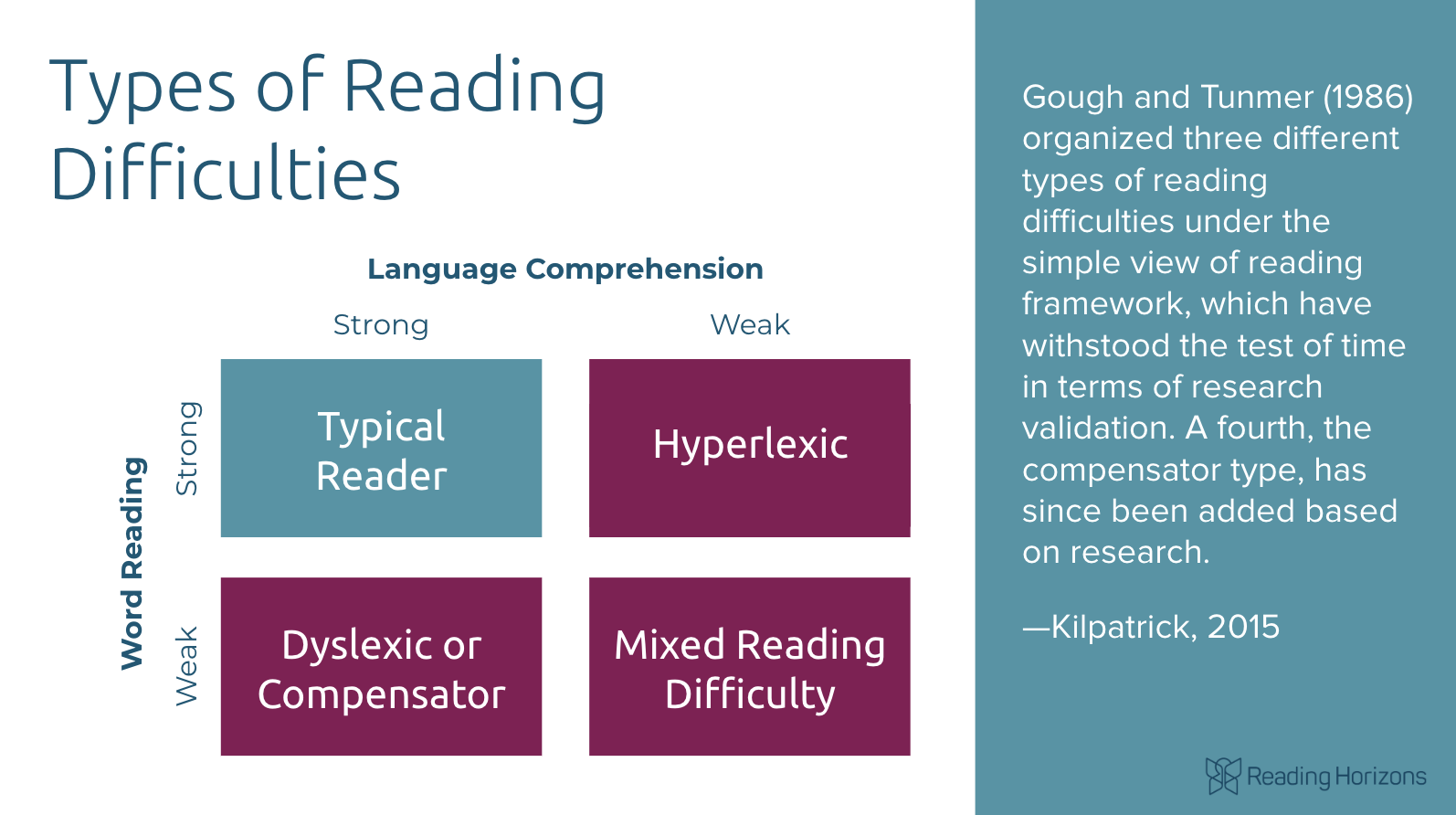Research shows that 95 percent of third-graders are cognitively capable of reading proficiently (Torgesen, 2004). The most effective action education leaders can take to ensure all students reach their full potential is aligning Tier 1 instruction with the science of reading. Yet, we know students with a specific learning difference need more practice opportunities to build their skills as they work to close the gap between their ability and grade-level standards. This blog will discuss how to write and monitor Individualized Education Program (IEP) goals that align with reading science so students receive appropriate services throughout their day.
The research is clear that targeted instruction and intervention are required to prevent students with specific learning needs in reading from falling further behind their peers. To determine goals, the IEP team must first identify the child’s Present Level of Performance (PLOP) so that there is a baseline for the child’s current academic and functional performance. This should describe the student’s ability to meet grade-level standards and skills.
PLOP Example: Susan is reading 15–20 words per minute (WPM) with three to eight errors in second-grade material. She reads slowly with inaccurate decoding skills.
IEP goals are then determined by the standards and the student’s unique needs.
These goals should be specific, observable, and measurable. Objectives for each goal are no longer required under IDEA 2004. However, the IEP team must describe how the student’s progress toward meeting the annual goals will be measured and reported. It must also include when parents or guardians will receive regular progress reports (e.g., each semester).
Needs Determine Goals and Goals Determine Services
Unless diagnosed before school age, students receiving special education services have typically gone through the Response to Intervention (RTI) process as part of a Multi-Tiered System of Supports (MTSS) framework. Yet, for many educators, the IEP process still feels murky, and they want to feel confident knowing that the IEP goals will yield the best outcomes for each of their learners.
These outcomes are greatly improved when education leaders and IEP teams understand how the brain learns to read and how to write IEP goals that address the different types of learning difficulties. Research has shown that students with reading difficulties fall into one of three categories as illustrated below (Spear-Swirling, 2015).

The highest percentage of students with specific learning differences in reading are those with dyslexia. These students may be very strong in language comprehension but have difficulty with word decoding. The compensator term in this category (added by Kilpatrick in 2015) describes students who may be identified much later because they could rely heavily on their language comprehension skills to overcome their decoding difficulties in early grades. These students often plateau when they reach upper grades because the volume and complexity of text exceed their ability to compensate with language.
Want to better support students with dyslexia, hyperlexia, or mixed reading difficulties? Learn how reading science can guide IEP development with our free webinar.
The next most common category for Specific Learning Disabilities (SLDs) in reading is students with mixed reading difficulty who have a combination of weaknesses in decoding and language comprehension. Finally, students with hyperlexia are sometimes referred to as word callers because of their proficiency with decoding. Their difficulty is in comprehending what they read, particularly related to semantics and inference.
Identifying the specific area of difficulty in the PLOP ensures that the IEP goals focus on where intervention is needed. These goals can be written in many ways and vary from district to district. When writing IEP goals for students with a specific learning difference in reading, there should be a clear explanation of what services will be provided, how frequently students will receive the services (and the number of minutes for each session/week), and the school setting where the service will occur. The IEP must also identify how the school will provide appropriate services for the student to reach the annual goals, be involved in and access content in the general education curriculum, and be educated with children who have different learning abilities to the greatest extent possible.
Typically, IEPs do not name a specific reading program, even when requested by parents, because of the legal requirement to provide what is written in the IEP, which a school cannot always meet. If the person certified in a specific intervention moves or retires, the school will be out of compliance. However, what can be identified is a description of the methodology used to provide the required services. A new provision of IDEA 2004 requires that special education and related services be provided through scientifically-based research methodologies to support evidence of their effectiveness. Interventions shown to be the most effective for students with reading difficulties include those based on the Orton-Gillingham approach and the Structured Literacy model, such as Reading Horizons.
Although programs such as Reading Horizons, for example, won’t be listed as a specific service in the IEP, the IEP goals can be written to target what will support the student’s progress in reading as connected to the components of effective reading instruction provided by the program. Additionally, it is particularly important to identify how progress toward the goal will be measured.
Non-Examples of IEP Goals
Many IEP goals in the past have been written for fluency and comprehension without first addressing foundational skills because these have been the focus of whole-language instruction. Although comprehension is the pinnacle of reading proficiency, research has shown that proficiency with phonemic awareness and decoding is essential for improving reading comprehension.
Beware of IEPs that are missing PLOP for these areas and goals that do not support accurate word reading when decoding is a contributing factor to poor fluency and comprehension. Grade level indicators as a measure of progress can be problematic—it is much more valid to use a specific quantifiable assessment measure. Goals such as those below do not meet the criteria for adequate goal statements.
- ____ will increase their reading fluency skills to a ____ grade level.
Typically, fluency goals are written to include an increase in WPM related to the student’s PLOP. This goal does not provide a measurable way of identifying progress from where the student started (WPM) or what text will be used to measure fluency. It also would not be an appropriate goal if the student has difficulty with accurate and automatic decoding and sight words since these are foundational to improving fluency.
- ____ will increase their reading comprehension skills to ____ grade level.
This goal is not specific enough and does not give any details about how this will be observed and measured.
- When given a passage at grade level, ____ will understand and answer comprehension questions.
This is another comprehension goal that does not contain observable and measurable metrics. There are no specifics about the type of comprehension questions and the accuracy expected to show progress.
Aligning IEP Goals to Reading Science
IEP goals are most effective when they focus on the specific needs of the student and target the area of literacy where intervention will be provided. It is important that IEP goals are aligned to the science of reading and best practices for increasing decoding skills and language comprehension. Some examples are included below.
- Given explicit instruction in phonemic awareness, including segmenting, ____ will be able to identify initial, medial, and final phonemes in predictable CVC words with __% accuracy and minimal cueing by the end of the IEP period.
- Given a series of CVC words at the end of the school year, ____ will be able to orally blend and segment with ___% accuracy as measured in five trials over a two-week period.
- Given multisensory language-based explicit instruction in decoding and word recognition skills, the student will be able to decode predictable words with the five single-syllable patterns with ___% accuracy.
- Given __ words in isolation at their instructional level, ___ will independently and accurately decode ___ % of single-syllable words with predictable patterns.
- After receiving explicit instruction, ______ will identify words with ch, sh, wh, and th-digraphs and decode and encode these words in isolation and in controlled text with __% accuracy.
- By the end of the IEP period, ______ will identify words with Murmur Diphthongs ar, or, er, ur, ir and decode those words in isolation with __% accuracy.
- After receiving instruction for decoding multisyllabic words, ___ will correctly segment at least __ of __ two-syllable words with predictable patterns by drawing slashes to properly divide and accurately decode the words.
- When given text or reading passages at their independent reading level, ____ will use knowledge of decoding skills and word recognition to increase their oral reading fluency with appropriate rate and expression to ___ words per minute with ___% accuracy.
- Given specialized instruction using a multisensory systematic phonics-based program, ___ will increase their reading comprehension level at the end of the school year to ___ grade level range as measured by ____.
- At the end of the IEP period, given four informational passages at their instructional level as identified by Lexile® measure, ___ will demonstrate the ability to accurately find specific details in text at an average of ____%.
Ways to Measure Student Response to Reading Horizons Instruction
| Tool | What can the tool measure? | Assesses Skill in Isolation | Assesses Skill in Context | Reading Horizons Discovery® | Reading Horizons Elevate® |
| Transfer Cards | Percentage of words correctly decoded | x | x | x | x |
| Dictation | Percentage of words spelled correctly | x | x | x | |
| Sentence Dictation | Percentage of skill words correctly spelled in sentences | x | x | x | |
| Practice Pages | Accuracy of skill in different contexts | x | x | x | |
| Skill Checks | Accuracy of skill in different contexts | x | x | x | |
| Reading Records | Fluency, comprehension, or accuracy rate | x | x | ||
| Software Lesson Reports | Accuracy of skill words in different contexts | x | x | x | x |
| RH Reading Assessment | Student Lexile® and comprehension | x | x | x | |
| Comprehension Quizzes | Main idea, specific details, vocabulary, and inference | x | x | ||
| Chapter Quizzes | Accuracy of skill in different contexts | x | x | ||
| Chapter Tests | Accuracy of skill in different contexts | x | x |
*Software usage does not count toward service minutes on an IEP, but data can be used to measure progress.
When K–3 students receive quality instruction aligned with the science of reading in general education and special education settings, we can expect their gaps to decrease much more rapidly than simply supporting them with these skills in one setting. Writing IEP goals for reading is much more effective when we have the right training for teachers across settings and the resources to ensure that every student is receiving the support they need.
Explore Reading Horizons’ resources and webinars designed to support effective literacy instruction.
